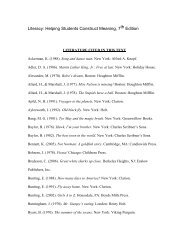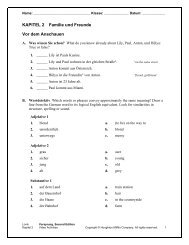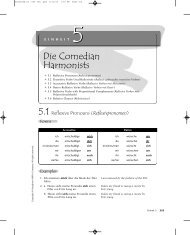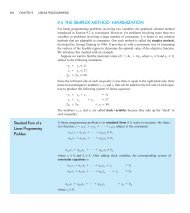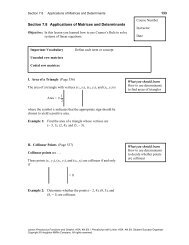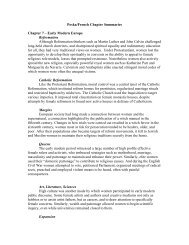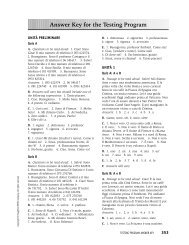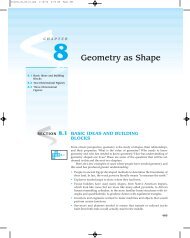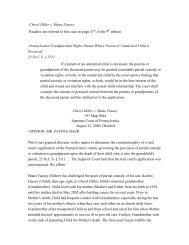SECTION 8.2 TWO-DIMENSIONAL FIGURES - Cengage Learning
SECTION 8.2 TWO-DIMENSIONAL FIGURES - Cengage Learning
SECTION 8.2 TWO-DIMENSIONAL FIGURES - Cengage Learning
Create successful ePaper yourself
Turn your PDF publications into a flip-book with our unique Google optimized e-Paper software.
304150_ch_08_02.qxd 1/16/04 6:07 AM Page 535<br />
■ Mathematics ■<br />
If you thought all mathematics<br />
proofs were like the twocolumn<br />
proofs in high school<br />
geometry, you were mistaken.<br />
Many, many mathematical<br />
proofs are fun and based on<br />
common sense that is<br />
accessible to all people!<br />
FIGURE 8.97<br />
FIGURE 8.95<br />
This is one of those cases where mathematics is counterintuitive. An exterior<br />
angle is an angle formed by a side of the polygon and the extension of the<br />
side adjacent to that side. Now go back and see whether you can draw the exterior<br />
angles for the two polygons. How many exterior angles does a polygon<br />
have? Then, and only then, look below. . . .<br />
C<br />
W<br />
FIGURE 8.96<br />
O<br />
Section <strong>8.2</strong> / Two-Dimensional Figures 535<br />
The diagrams in Figure 8.96 illustrate the exterior angles. As you may have<br />
guessed, there is an exterior angle associated with each interior angle.<br />
The sum of the interior angles of a polygon is 180n 2. What do you<br />
think is the sum of the exterior angles of a polygon? . . .<br />
Amazingly, the sum of the exterior angles of any polygon is 360 degrees.<br />
You can see the proof for yourself by placing a pencil on vertex C of the triangle<br />
above. Now “walk” the pencil around the triangle. That is, move it to vertex O,<br />
now rotate the pencil so you are pointing toward W; note that the amount of<br />
turn is exactly the exterior angle at O. Now walk the pencil to W. Turn the pencil<br />
at W so you are pointing toward C; again, the amount of turn is equal to the<br />
exterior angle at W. Finally walk to C and turn to face O. You find that the pencil<br />
has made one complete turn. Do the same with quadrilateral PONY. Once<br />
again, you find you make one complete turn.<br />
All polygons have interior and exterior angles. When we focus on regular<br />
polygons, there is an additional kind of angle. A central angle of a regular polygon<br />
consists of a vertex at the center of the polygon and the two sides connecting<br />
the center to adjacent vertices of the polygon (see Figure 8.97). The size of<br />
the central angle is not difficult to determine if you recall that one complete<br />
turn around a point is equal to 360 degrees. The measure of the central angle of<br />
a regular n-gon (a polygon with n sides) is equal to 360n degrees. This and<br />
other theorems developed in this section are used to advance our understanding<br />
of the structure of geometry, which is then used by people in various fields.<br />
For example, graphic artists use their sense of geometric structure to make very<br />
beautiful and intricate designs, both on everyday objects like fabric and posters<br />
and as pieces of art.<br />
P<br />
Y<br />
O<br />
N




